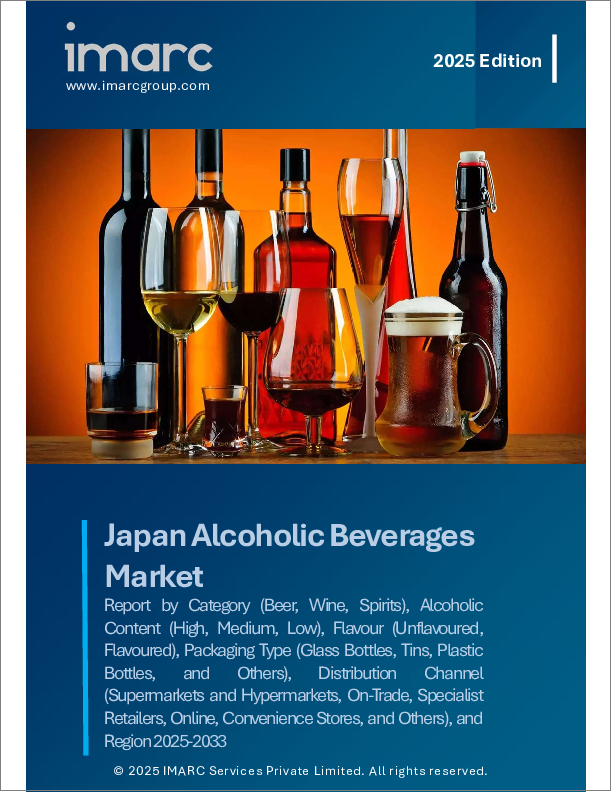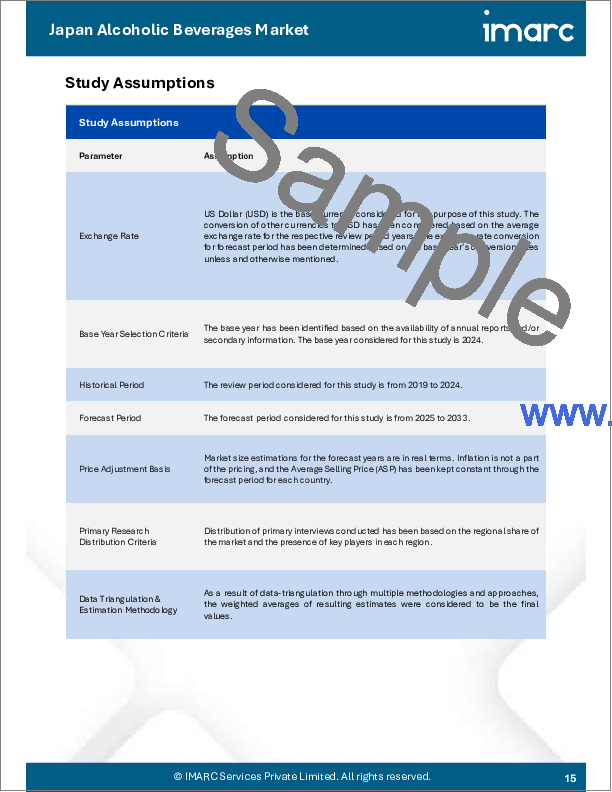|
|
市場調査レポート
商品コード
1746676
日本のアルコール飲料市場レポート:カテゴリー別、アルコール度数別、フレーバー別、包装タイプ別、流通チャネル別、地域別、2025年~2033年Japan Alcoholic Beverages Market Report by Category, Alcoholic Content, Flavour, Packaging Type, Distribution Channel, and Region 2025-2033 |
||||||
カスタマイズ可能
|
|||||||
| 日本のアルコール飲料市場レポート:カテゴリー別、アルコール度数別、フレーバー別、包装タイプ別、流通チャネル別、地域別、2025年~2033年 |
|
出版日: 2025年06月02日
発行: IMARC
ページ情報: 英文 119 Pages
納期: 5~7営業日
|
全表示
- 概要
- 目次
日本のアルコール飲料市場規模は2024年に120億リットルに達しました。IMARCグループは、2033年には162億リットルに達し、2025~2033年の成長率(CAGR)は3.23%になると予測しています。特定のアルコール飲料に対する消費者の選択に影響を与えることができる創造的な広告、推薦、ソーシャルメディアキャンペーンなどの効果的なマーケティングおよびブランディング戦略に対する需要の増加が、主に市場を牽引しています。
本レポートで扱う主な質問
- 日本のアルコール飲料市場はこれまでどのように推移してきたか?
- COVID-19が日本のアルコール飲料市場に与えた影響は?
- 日本のアルコール飲料市場のカテゴリー区分は?
- 日本のアルコール飲料市場のアルコール度数別区分は?
- 日本のアルコール飲料市場のフレーバー別の区分は?
- 日本のアルコール飲料市場の包装タイプ別区分は?
- 日本のアルコール飲料市場の流通チャネル別区分は?
- 日本のアルコール飲料市場のバリューチェーンにおける様々なステージとは?
- 日本のアルコール飲料の主要な促進要因と課題は何か?
- 日本のアルコール飲料市場の構造と主要企業は?
- 日本のアルコール飲料市場における競合の程度は?
目次
第1章 序文
第2章 調査範囲と調査手法
- 調査の目的
- ステークホルダー
- データソース
- 市場推定
- 調査手法
第3章 エグゼクティブサマリー
第4章 日本のアルコール飲料市場-イントロダクション
- 概要
- 市場力学
- 業界動向
- 競合情報
第5章 日本のアルコール飲料市場情勢
- 過去および現在の市場動向(2019~2024年)
- 市場予測(2025~2033年)
第6章 日本のアルコール飲料市場- カテゴリー別の内訳
- ビール
- ワイン
- スピリッツ
第7章 日本のアルコール飲料市場- アルコール度数別の内訳
- 高
- 中
- 低
第8章 日本のアルコール飲料市場- フレーバー別の内訳
- 無味
- フレーバー付き
第9章 日本のアルコール飲料市場- 包装タイプ別の内訳
- ガラス瓶
- 缶詰
- ペットボトル
- その他
第10章 日本のアルコール飲料市場- 流通チャネル別の内訳
- スーパーマーケットとハイパーマーケット
- オントレード
- 専門小売業者
- オンライン
- コンビニエンスストア
- その他
第11章 日本のアルコール飲料市場-競合情勢
- 概要
- 市場構造
- 市場企業のポジショニング
- 主要成功戦略
- 競合ダッシュボード
- 企業評価象限
第12章 主要企業のプロファイル
第13章 日本のアルコール飲料市場- 業界分析
- 促進要因・抑制要因・機会
- ポーターのファイブフォース分析
- バリューチェーン分析
第14章 付録
Japan alcoholic beverages market size reached 12.0 Billion Litres in 2024. Looking forward, IMARC Group expects the market to reach 16.2 Billion Litres by 2033, exhibiting a growth rate (CAGR) of 3.23% during 2025-2033. The increasing demand for effective marketing and branding strategies, such as creative advertising, endorsements, and social media campaigns that can influence consumer choices for specific alcoholic beverages, is primarily driving the market.
Alcoholic beverages, also known as alcohol or spirits, have been consumed by humans for thousands of years. They are drinks that contain ethanol, a psychoactive substance produced through the fermentation of sugars by yeast. These beverages come in various forms, including beer, wine, and distilled spirits. Beer, one of the oldest alcoholic drinks, is made from fermented grains such as barley and wheat. It has a relatively low alcohol content and is enjoyed for its diverse flavors and styles. Wine is crafted from fermented grapes, and its production dates back to ancient civilizations. It offers a wide range of flavors, aromas, and styles, from dry and light to sweet and fortified. Distilled spirits like whiskey, vodka, and rum are created through distillation, a process that increases alcohol content. They are known for their potency and can be enjoyed straight, in cocktails, or as part of various culinary traditions. Alcoholic beverages have cultural, social, and economic significance in many societies, often playing a central role in celebrations and rituals.
Japan Alcoholic Beverages Market Trends:
The alcoholic beverages market in Japan has witnessed substantial growth in recent years, primarily due to several key drivers. Firstly, changing consumer preferences has played a pivotal role in reshaping the market landscape. Consumers are increasingly seeking unique and diverse alcoholic beverages, leading to a surge in craft breweries, distilleries, and wineries. Consequently, this has spurred innovation and competition, further boosting market growth. Furthermore, the rise of e-commerce and online retail platforms has made it easier for consumers to access and purchase alcoholic beverages, facilitating convenience and choice. The convenience factor, coupled with the ease of online product discovery and delivery, has significantly influenced market dynamics. Additionally, social trends and the growth of the experiential economy have propelled the demand for premium and high-end alcoholic beverages. Consumers are increasingly willing to spend on premium options, reflecting a willingness to explore new tastes and indulge in luxurious experiences. In conclusion, the regional alcoholic beverages market is expected to be driven by evolving consumer preferences, e-commerce, and the premiumization trend.
Japan Alcoholic Beverages Market Segmentation:
Category Insights:
- Beer
- Wine
- Still Light Wine
- Sparkling Wine
- Spirits
- Baijiu
- Vodka
- Whiskey
- Rum
- Liqueurs
- Gin
- Tequila
- Others
Alcoholic Content Insights:
- High
- Medium
- Low
Flavour Insights:
- Unflavoured
- Flavoured
Packaging Type Insights:
- Glass Bottles
- Tins
- Plastic Bottles
- Others
Distribution Channel Insights:
- Supermarkets and Hypermarkets
- On-Trade
- Specialist Retailers
- Online
- Convenience Stores
- Others
Competitive Landscape:
The market research report has also provided a comprehensive analysis of the competitive landscape. Competitive analysis such as market structure, key player positioning, top winning strategies, competitive dashboard, and company evaluation quadrant has been covered in the report. Also, detailed profiles of all major companies have been provided. Some of the key players include:
- Asahi Group Holdings Ltd.
- Kirin Holdings Company Limited
- Sapporo Breweries Ltd.
- Suntory Holdings Limited
- Takara Holdings Inc.
- Tokuoka Co. Ltd.
Key Questions Answered in This Report:
- How has the Japan alcoholic beverages market performed so far and how will it perform in the coming years?
- What has been the impact of COVID-19 on the Japan alcoholic beverages market?
- What is the breakup of the Japan alcoholic beverages market on the basis of category?
- What is the breakup of the Japan alcoholic beverages market on the basis of alcoholic content?
- What is the breakup of the Japan alcoholic beverages market on the basis of flavour?
- What is the breakup of the Japan alcoholic beverages market on the basis of packaging type?
- What is the breakup of the Japan alcoholic beverages market on the basis of distribution channel?
- What are the various stages in the value chain of the Japan alcoholic beverages market?
- What are the key driving factors and challenges in the Japan alcoholic beverages?
- What is the structure of the Japan alcoholic beverages market and who are the key players?
- What is the degree of competition in the Japan alcoholic beverages market?
Table of Contents
1 Preface
2 Scope and Methodology
- 2.1 Objectives of the Study
- 2.2 Stakeholders
- 2.3 Data Sources
- 2.3.1 Primary Sources
- 2.3.2 Secondary Sources
- 2.4 Market Estimation
- 2.4.1 Bottom-Up Approach
- 2.4.2 Top-Down Approach
- 2.5 Forecasting Methodology
3 Executive Summary
4 Japan Alcoholic Beverages Market - Introduction
- 4.1 Overview
- 4.2 Market Dynamics
- 4.3 Industry Trends
- 4.4 Competitive Intelligence
5 Japan Alcoholic Beverages Market Landscape
- 5.1 Historical and Current Market Trends (2019-2024)
- 5.2 Market Forecast (2025-2033)
6 Japan Alcoholic Beverages Market - Breakup by Category
- 6.1 Beer
- 6.1.1 Overview
- 6.1.2 Historical and Current Market Trends (2019-2024)
- 6.1.3 Market Forecast (2025-2033)
- 6.2 Wine
- 6.2.1 Overview
- 6.2.2 Historical and Current Market Trends (2019-2024)
- 6.2.3 Market Segmentation
- 6.2.3.1 Still Light Wine
- 6.2.3.2 Sparkling Wine
- 6.2.4 Market Forecast (2025-2033)
- 6.3 Spirits
- 6.3.1 Overview
- 6.3.2 Historical and Current Market Trends (2019-2024)
- 6.3.3 Market Segmentation
- 6.3.3.1 Baijiu
- 6.3.3.2 Vodka
- 6.3.3.3 Whiskey
- 6.3.3.4 Rum
- 6.3.3.5 Liqueurs
- 6.3.3.6 Gin
- 6.3.3.7 Tequila
- 6.3.3.8 Others
- 6.3.4 Market Forecast (2025-2033)
7 Japan Alcoholic Beverages Market - Breakup by Alcoholic Content
- 7.1 High
- 7.1.1 Overview
- 7.1.2 Historical and Current Market Trends (2019-2024)
- 7.1.3 Market Forecast (2025-2033)
- 7.2 Medium
- 7.2.1 Overview
- 7.2.2 Historical and Current Market Trends (2019-2024)
- 7.2.3 Market Forecast (2025-2033)
- 7.3 Low
- 7.3.1 Overview
- 7.3.2 Historical and Current Market Trends (2019-2024)
- 7.3.3 Market Forecast (2025-2033)
8 Japan Alcoholic Beverages Market - Breakup by Flavour
- 8.1 Unflavoured
- 8.1.1 Overview
- 8.1.2 Historical and Current Market Trends (2019-2024)
- 8.1.3 Market Forecast (2025-2033)
- 8.2 Flavoured
- 8.2.1 Overview
- 8.2.2 Historical and Current Market Trends (2019-2024)
- 8.2.3 Market Forecast (2025-2033)
9 Japan Alcoholic Beverages Market - Breakup by Packaging Type
- 9.1 Glass Bottles
- 9.1.1 Overview
- 9.1.2 Historical and Current Market Trends (2019-2024)
- 9.1.3 Market Forecast (2025-2033)
- 9.2 Tins
- 9.2.1 Overview
- 9.2.2 Historical and Current Market Trends (2019-2024)
- 9.2.3 Market Forecast (2025-2033)
- 9.3 Plastic Bottles
- 9.3.1 Overview
- 9.3.2 Historical and Current Market Trends (2019-2024)
- 9.3.3 Market Forecast (2025-2033)
- 9.4 Others
- 9.4.1 Historical and Current Market Trends (2019-2024)
- 9.4.2 Market Forecast (2025-2033)
10 Japan Alcoholic Beverages Market - Breakup by Distribution Channel
- 10.1 Supermarkets and Hypermarkets
- 10.1.1 Overview
- 10.1.2 Historical and Current Market Trends (2019-2024)
- 10.1.3 Market Forecast (2025-2033)
- 10.2 On-Trade
- 10.2.1 Overview
- 10.2.2 Historical and Current Market Trends (2019-2024)
- 10.2.3 Market Forecast (2025-2033)
- 10.3 Specialist Retailers
- 10.3.1 Overview
- 10.3.2 Historical and Current Market Trends (2019-2024)
- 10.3.3 Market Forecast (2025-2033)
- 10.4 Online
- 10.4.1 Overview
- 10.4.2 Historical and Current Market Trends (2019-2024)
- 10.4.3 Market Forecast (2025-2033)
- 10.5 Convenience Stores
- 10.5.1 Overview
- 10.5.2 Historical and Current Market Trends (2019-2024)
- 10.5.3 Market Forecast (2025-2033)
- 10.6 Others
- 10.6.1 Historical and Current Market Trends (2019-2024)
- 10.6.2 Market Forecast (2025-2033)
11 Japan Alcoholic Beverages Market - Competitive Landscape
- 11.1 Overview
- 11.2 Market Structure
- 11.3 Market Player Positioning
- 11.4 Top Winning Strategies
- 11.5 Competitive Dashboard
- 11.6 Company Evaluation Quadrant
12 Profiles of Key Players
- 12.1 Asahi Group Holdings Ltd.
- 12.1.1 Business Overview
- 12.1.2 Product Portfolio
- 12.1.3 Business Strategies
- 12.1.4 SWOT Analysis
- 12.1.5 Major News and Events
- 12.2 Kirin Holdings Company Limited
- 12.2.1 Business Overview
- 12.2.2 Product Portfolio
- 12.2.3 Business Strategies
- 12.2.4 SWOT Analysis
- 12.2.5 Major News and Events
- 12.3 Sapporo Breweries Ltd.
- 12.3.1 Business Overview
- 12.3.2 Product Portfolio
- 12.3.3 Business Strategies
- 12.3.4 SWOT Analysis
- 12.3.5 Major News and Events
- 12.4 Suntory Holdings Limited
- 12.4.1 Business Overview
- 12.4.2 Product Portfolio
- 12.4.3 Business Strategies
- 12.4.4 SWOT Analysis
- 12.4.5 Major News and Events
- 12.5 Takara Holdings Inc.
- 12.5.1 Business Overview
- 12.5.2 Product Portfolio
- 12.5.3 Business Strategies
- 12.5.4 SWOT Analysis
- 12.5.5 Major News and Events
- 12.6 Tokuoka Co. Ltd.
- 12.6.1 Business Overview
- 12.6.2 Product Portfolio
- 12.6.3 Business Strategies
- 12.6.4 SWOT Analysis
- 12.6.5 Major News and Events
13 Japan Alcoholic Beverages Market - Industry Analysis
- 13.1 Drivers, Restraints, and Opportunities
- 13.1.1 Overview
- 13.1.2 Drivers
- 13.1.3 Restraints
- 13.1.4 Opportunities
- 13.2 Porters Five Forces Analysis
- 13.2.1 Overview
- 13.2.2 Bargaining Power of Buyers
- 13.2.3 Bargaining Power of Suppliers
- 13.2.4 Degree of Competition
- 13.2.5 Threat of New Entrants
- 13.2.6 Threat of Substitutes
- 13.3 Value Chain Analysis






